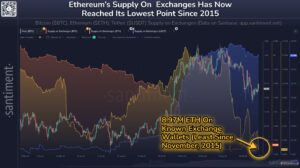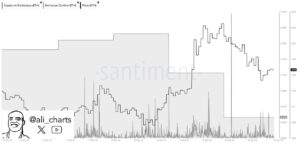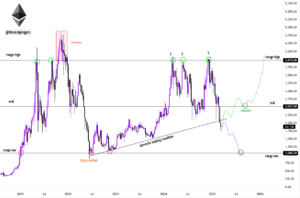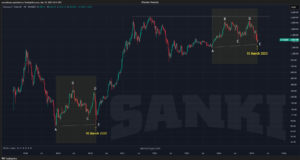- Ethereum’s exchange holdings have dropped to a 10-year low, indicating reduced selling pressure.
- Market sentiment remains mixed, with predictions ranging from bullish surges to further price declines.
Ethereum’s available supply on crypto exchanges has fallen to its lowest point since November 2015, with just 8.97 million ETH remaining. This decline is largely due to increased staking and DeFi options, which have encouraged holders to move their assets off exchanges.
Santiment reported that over the past seven weeks alone, the supply has dropped by 16.4%, highlighting a shift in investor behavior. The trend suggests that fewer holders are willing to sell, potentially reducing selling pressure in the market.

In the past 48 hours, a staggering 360,000 ETH has been withdrawn from exchanges. As Ethereum continues to play a crucial role in the crypto ecosystem, many are debating whether this declining supply signals an impending price rally or a structural shift in market dynamics.

ETH Risks Drop to $1,500 if Support Fails
Ethereum is currently priced at $1,972.87 with a gain of 4% in the past seven days. Nevertheless, there is still a disconnect in the market about what it is going to do next. Some are sure that Ethereum’s position near $2,100 is a make-or-break test of support.
In case of positive market trends, ETH might hold above this support and maintain the mid-term target of $4,000. Some estimates even go as far as to say that ETH might cross this milestone by 2025.
On the contrary, a breakdown below $2,100 can lead to a bearish retest that can take prices down to about $1,500 to $1,600.
The Ethereum price has continued to fight with resistance levels around $4,000 on several occasions, with breakouts not succeeding in this cycle.

If downward momentum continues, Ethereum can test its previous range low of $1,060. Success in re-taking the $2,500 mark can pave the way for a second attempt to breach $4,000.
Some experts are saying that Ethereum’s long-term trend is in line with previous accumulation periods. They point to previous patterns such as the build-up in 2019–2020 that resulted in a sudden drop before a record peak.

The same pattern has repeated in recent times with speculations that Ethereum has already hit bottom.
Ethereum’s Relationship with Layer-2 Networks
Another important consideration for Ethereum’s ecosystem is how it connects with Layer-2 (L2) solutions. Such scalability solutions as Optimism and Base are gaining prominence and generating significant revenue.
Ethereum is bleeding value to L2s. Rollups extract fees, MEV, and liquidity while ETH stakers get left behind. If this keeps up, Ethereum becomes a dumb security layer while L2s print money. Does this sound like a decent model for fixing it? 🧵👇
— zak.eth (@0xzak) March 14, 2025
There are fears that Ethereum is losing value to these L2 networks as they are capturing fees and liquidity without properly contributing to Ethereum’s staking and security ecosystem.
L2 networks do not require ETH to pay gas charges, yet they still utilize Ethereum for security. Currently, L2s are paying only a fraction of their revenue to Ethereum.
For instance, last month Base collected around $2.5 million in fees and contributed less than $11,000 to Ethereum’s chain. Optimism’s revenue is even more disproportionate and collects about $321 in L2 fees for every $1 it pays to Ethereum.
To make Ethereum sustainable in the long run, experts advise that L2 networks can do more. The solutions proposed are to make it necessary for L2 sequencers to post ETH as collateral, to return a share of L2 charges to Ethereum stakers, and to restructure Maximum Extractable Value (MEV) distribution.
Implementing such measures could help maintain Ethereum’s dominance as the primary settlement layer while ensuring that L2 networks align with its long-term growth.



